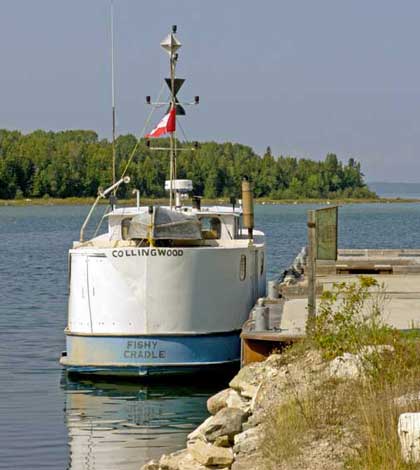ONTARIO—Ontario’s Minister of Energy Bob Chiarelli announced last Wednesday that the province would begin to pay wind power generators not to produce energy in an attempt to save taxpayers upwards of $200 million annually.
Since 2006, Ontario has seen a surplus in energy but until September 11 the government has paid for all generated electricity, needed or not.
Paying producers not to do just that is nothing new for the Ontario government as it currently pays Bruce Power to not churn out energy in times of surplus.
“It’s unbelievable,” said Ray Beaudry, spokesperson for the Manitoulin Coalition for Safe Energy Alternatives (MCSEA) from his home just below the site of the 24-turbine wind development on McLean’s Mountain currently under construction. “The province is broke and hydro rates continue to escalate. Why are they still proceeding with this mandate?” Mr. Beaudry questioned. “The province is climbing into energy poverty.”
He said he is doubtful the government will cancel any of the green energy projects it has signed contracts with for fear of political retribution similar to the Ontario Liberals’ gas plant scandal. “There’s no escape clause to get out of it and it’s the consumers that pay,” Mr. Beaudry added.
“It’s a flawed energy policy, but they can’t get out of them,” he continued. “It’s just not economically viable to continue with these projects.”
Peter Tabuns, NDP energy critic, told The Expositor that last week’s announcement brings wind in line with nuclear, as so far this year Bruce Power has been paid $60 million to not produce energy.
“Liberals have heavily overbuilt wind generation,” he said, noting that he doubted whether the $200 million was just for wind, when one factors in the $60 million figure for Bruce Power alone.
There are currently 2,000 MW of wind in the system that has a capacity of 4,000 MW, he added.
“I think they’re building a lot more wind and nuclear than we need,” Mr. Tabuns said. He said that one day, some of the province’s reactors will come to their end, either becoming too expensive to retrofit or simply in need of shutting down with the reduction in power finally meeting the province’s demands.
“New rules from the Independent Electricity Operator enabling the “dispatch” of wind generation in Ontario’s electricity system came into effect on September 11, 2013,” Beckie Codd-Downey, press secretary for the Ministry of Energy, told The Expositor in a statement prepared to answer questions posed by the paper. “The new rules allow wind turbines to be turned off when their generation is not needed. These new rules will provide significant ratepayer savings. For example, according to the Independent Electricity System Operator, making wind dispatchable is expected to save Ontario ratepayers at least $200 million every year.”
“Most other sources of energy in the province already have this dispatch ability,” Ms. Codd-Downey continued. “Because supply and demand conditions vary throughout the course of a day, we have to ensure that our electricity system is flexible enough to respond to changing conditions. That includes some compensation to power producers—including nuclear, gas, biomass, and wind—at times when their generation is not required. This approach is used in other jurisdictions and will help ensure that Ontarians continue to benefit from a reliable and clean supply of electricity.”
“Investments in renewable technology, like hydro, wind and solar, have helped the province to move away from dirty coal, protect our environment and improve our health,” she added. “The excellent supply conditions in Ontario today are in stark contrast to the shortages witnessed about a decade ago.”
“As of June 2013, the Ontario Power Authority was managing 123 wind contracts, representing a total of over 5,700 MW,” Ms. Beckie Codd-Downey continued. “Of this total, 58 contracts (representing over 2,100 MW) were in service and 65 contracts (representing over 3,500 MW) were under development. The OPA will continue to honour existing renewable energy contracts.”
“Well don’t worry, they weren’t generating much anyway,” joked Vic Fedeli, Progressive Conservative energy critic and Nipissing MPP.
“This is a complete and utter admission that the Green Energy Act is a complete failure,” he added. “They’re trying to alleviate the criticism and account for the fact that we’ve paid so much money to the States. Half a billion we’re paying to have that surplus power.”
“This is just an absolutely ridiculous new ruling that’s going to cost money,” Mr. Fedeli said.
“I was on Manitoulin with my megaphone, I know the community does not want those turbines—they’re an awful blight on the landscape,” he continued.
“There’s nothing green about the Green Energy Act. Water power, the cleanest power there is, has been cut from 25 percent to 22 percent with an added three percent of wind. After billions of dollars spent, 25 percent of the total is still green energy—nothing has changed.”
“And when they say they’re going to save $200 million, don’t believe it—we don’t believe any amounts the Liberals give us,” Mr. Fedeli concluded, pointing to the gas plant scandals plaguing the province’s leaders.
Minister Chiarelli has answered Mr. Fedeli’s criticism by saying that Ontario is making a net profit of up to $6 billion a year on importing and exporting electricity, a turnaround from a decade ago when the province paid $500 million to import power because it didn’t have enough to meet demand.
While it isn’t unusual for neighbouring jurisdictions to sell each other electricity, Ontario would frequently have to pay Quebec or New York State to take the excess power off its hands.
Expositor correction
Following the September 18 page 1 article ‘Province paying wind farms for non-generation of power,’ NDP energy critic Peter Tabuns wrote The Expositor saying that he made the following statement: “I said in answer to questions by your reporter that Ontario had overbuilt nuclear and gas generation, not wind. And in fact, that is the case. Wind is still a small part of total electricity production in Ontario. Our electricity overproduction and subsidy problem comes from the huge amounts we are paying for overbuilt nuclear and gas plants.”





